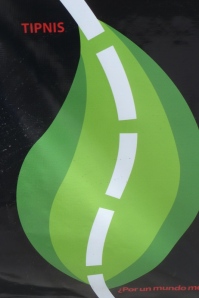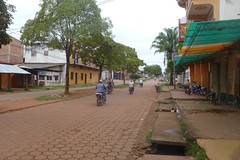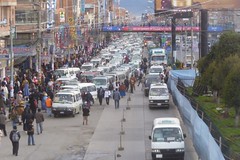CONISUR march to demand road through TIPNIS national park
18 January 2012
Dario Kenner, La Paz
Updates on Bolivia: Twitter: @dariokenner / Facebook: http://www.facebook.com/BoliviaDiary
A march that began on 20 December 2011 demanding the Bolivian government builds a road through the TIPNIS national park and indigenous territory is close to reaching La Paz. This pro-road march wants the law approved in October by President Evo Morales that strictly prohibited the road through the TIPNIS to be reversed. The Bolivian government approved the law after a two month long anti-road march by members of indigenous movements CIDOB and CONAMAQ (photo essay).
Why is there a march in support of the road?
The TIPNIS conflict has caused deep divisions within Bolivia since August 2010 when the anti-road indigenous march set off on its way to La Paz. The issue sparked an intense debate on the rights of Bolivia´s indigenous peoples and what type of development the country needs. As Indian Country reported in December: “Bolivia’s indigenous population is far from monolithic. There are indigenous and multicultural groups that support the road, including the country’s largest rural union organization and coca growers, part of the president’s key support base.”
The Bolivian government has always maintained the road will lead to development for the indigenous communities living in TIPNIS, the regions of Beni and Cochabamba and for the country as whole. The government maintains that agricultural producers in Beni and Cochabamba will have increased access to markets for their goods and that the road will increase the integration of Bolivia and access to electricity and public services. As a rally in October 2011 showed the Morales government can count on substantial support for its policy programme. A government organised summit with civil society in mid-January 2012 concluded the road through TIPNIS should be reconsidered.
Who are CONISUR?
The pro-road march of around 1,000 people is led by CONISUR (Indigenous Council of the South) and will have covered over 400 kilometres by the time it reaches La Paz. This is a organisation that groups together 21 indigenous communities with 12 living in the south of the TIPNIS indigenous territory and another 9 in an area known as Poligono 7 that was occupied by around 20,000 people, mainly coca growers (cocaleros), that was separated off from the original indigenous territory in 2009 (see map). 15 CONISUR communities are marching: 6 from inside the TIPNIS indigenous territory and all 9 from the Poligono 7.
CONISUR demands include repealing the law banning the road, the construction of the road through the middle of the national park, funding for agriculture projects and the protection of the TIPNIS indigenous territory. In mid-January Gumercindo Pradel, President of CONISUR, said the law banning the road had not been consulted on with all the communities within the TIPNIS and therefore should be repealed. “A few bad leaders who have all they need should not oppose our progress”, he said.

TIPNIS national park and indigenous territory. White areas have been deforested. The area in the south known as Poligono 7 has been occupied mainly by coca growers and is no longer part of the indigenous autonomous territory: Bolivian Agency for Protected Areas (credit: SERNAP August 2011)
I asked Sarela Paz, an expert on TIPNIS and a member of the team that completed a Strategic Environmental Evaluation of the TIPNIS in 2011, about the complex make up of indigenous organisations within the indigenous territory (http://www.cedib.org/bp/2011/09/s/sarela.pdf). She explains, “the TIPNIS is made up of several indigenous organisations. Following the 1990 march (the first march by Bolivia´s lowland indigenous peoples that pressured the government to pass supreme decree 22610 declaring TIPNIS an indigenous territory) the TIPNIS subcentral was established grouping together all 63 communities inside TIPNIS.
But in the last 10 years two other organisations were created and now the TIPNIS subcentral brings together 37 communities. The Sécure subcentral represents 14 communities but it recognises the TIPNIS Subcentral as the representative organisation and therefore defers to it. CONISUR represents 21 indigenous communities who either live close to the occupied Poligono 7 (in total 12 communities) or inside it (9 communities)”.
Sarela Paz goes on to explain that the only communities that can be consulted on the road through the TIPNIS are those within the indigenous territory via their representative institutions. In the case of TIPNIS these are the TIPNIS subcentral, the Sécure subcentral and the 12 communities affiliated to CONISUR. However, she highlights that 9 communities that are part of CONISUR live outside the official indigenous territory (TCO) and therefore cannot be consulted. They can voice their views on the road but they cannot be part of a consultation – which is meant to be prior.
The experience in the occupied south of the TIPNIS national park – Poligono 7
“The coca economy has affected the way of life of the 9 indigenous communities inside the Poligono 7 in terms of their economic activity and daily tasks. It is not about the indigenous communities deciding to become cocaleros. They are under huge pressure and surrounded by cocalero communities. The clearest example of this is in a change in vision from the collective to the individual use of the land”, comments Sarela Paz.
In early January 2012 it was revealed seven CONISUR communities produce coca and are affiliated to the Six Federation of the Tropics (cocaleros union) headed by President Evo Morales.
Finally, Sarela Paz confirms there is already a road that goes into the Poligono 7 that the 10 CONISUR communities have access to. “Why are they marching if there is already a road?”, she asks. The CONISUR demand is that a road goes through the entire TIPNIS up to the region of the Beni.
The CONISUR pro-road march is expected to arrive in La Paz soon. The reception they receive from the populations of El Alto and La Paz could be important in determining whether they are successful in their aim to repeal the law currently barring the building of the road through the TIPNIS.
——————————————–
Full interview with Sarela Paz can be found here.
For analysis of what reversing the TIPNIS law could mean see Bolivia Diary article “Bolivian government close to reversing law that prohibits road through TIPNIS national park“.
In understanding why the CONISUR communities want the road it is important to understand their different views of “development”. This comprehensive article by Courtney Frantz at the Council on Hemispheric Affairs gives an insight into the different perspectives and also discusses the tensions between economic growth and indigenous rights for left-wing governments.







Comments
5 Responses to “CONISUR march to demand road through TIPNIS national park”Trackbacks
Check out what others are saying...[…] of Law 180 and for the road to be built through the TIPNIS (for more information see Bolivia Diary article on the CONISUR march and interview with expert on TIPNIS Sarela […]
[…] prohibited the road through the TIPNIS to be reversed” Dario Kenner explains in the blog Bolivia Diary. Tweet Last year we reported extensively on a march to protest a road that would go through […]
[…] que eminentemente proibiu a rodovia que atravessaria o TIPNIS”, explica Dario Kenner no blog Bolivia Diary [en]. Tweet Ano passado [en] cobrimos extensamente a marcha contra uma rodovia que […]
[…] begins a pro-road march, hoping to reverse the gains of October. Fellow blogger Dario Kenner gives this description of the pro-road marchers: “This is an organization that groups together 21 indigenous […]
[…] mese di dicembre, tuttavia, il Consiglio Indigeno del Sud (CONISUR) – formato da comunità indigene che vivono sulle pianure tra il TIPNIS e il “Poligono […]